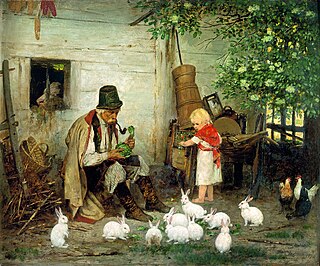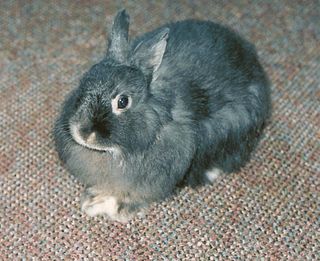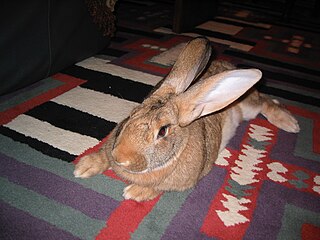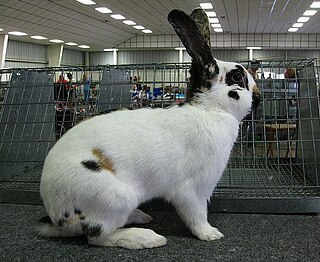
Cuniculture is the agricultural practice of breeding and raising domestic rabbits as livestock for their meat, fur, or wool. Cuniculture is also employed by rabbit fanciers and hobbyists in the development and betterment of rabbit breeds and the exhibition of those efforts. Scientists practice cuniculture in the use and management of rabbits as model organisms in research. Cuniculture has been practiced all over the world since at least the 5th century.

The Angora rabbit, which is one of the oldest types of domestic rabbit, is bred for the long fibers of its coat, known as Angora wool, which are gathered by shearing, combing or plucking. Because rabbits do not possess the same allergy-causing qualities as many other animals, their wool is an important alternative. There are at least 11 distinct breeds of Angora rabbit, four of which are currently recognized by the American Rabbit Breeders Association (ARBA): English Angora, French Angora, Giant Angora and Satin Angora. Others include German Angora, Chinese Angora, Finnish Angora, Japanese Angora, Korean Angora, Russian Angora, St Lucian Angora and Swiss Angora.

The Netherland Dwarf is a breed of domestic rabbit that originated in the Netherlands. Weighing 1.1–2.5 pounds (0.50–1.13 kg), the Netherland Dwarf is one of the smallest rabbit breeds. Its popularity as a pet or show rabbit may stem from its neotenic appearance. The Netherland Dwarf is recognised by both the American Rabbit Breeders Association (ARBA) and the British Rabbit Council (BRC). The Netherland Dwarf is often confused with the Polish breed of rabbit, but the latter has longer ears, a non-brachycephalic head and less cobbiness.

The Jersey Wooly is a breed of domestic rabbit weighing about 3 pounds with a bold head and easy-care wool fur on their body. They are noted for their docile nature, and gentle disposition.

The Californian, also known as the California White, is a breed of domestic rabbit originally developed for the fur and meat industries by George S. West of Lynwood, California, starting in 1923. West maintained a herd of 300 genetically pure New Zealand Whites, which he began crossing with Standard Chinchilla rabbits for their dense coat, and Himalayan rabbits. This new breed, named for the state of its origin, was first shown in 1928 and a standard was accepted by the American Rabbit Breeders Association (ARBA) in 1939.

The Mini Lop is a breed of domestic rabbit that is recognized by the American Rabbit Breeders Association (ARBA). It is different from the Miniature Lop breed that is recognized by the British Rabbit Council (BRC). The Mini Lop [US] and the Miniature Lop [UK] are different from the Dwarf Lop breed that is recognized by the BRC. The Mini Lop is similar to several other small rabbit breeds, such as the Dwarf rabbit.

Holland Lop is a breed of lop-eared rabbit that was recognized by the American Rabbit Breeders Association (ARBA) in 1979. The Holland Lop, with a maximum weight of 1.8 kg (4 lb), is one of the smallest lop-eared breeds.

The American Fuzzy Lop is a rabbit breed recognized by the American Rabbit Breeders Association (ARBA). It is similar in appearance to a Holland Lop. However, the American Fuzzy Lop is a wool breed and will have wool similar to the Angora breeds although the wool will be shorter than that of a commercial Angora. The American fuzzy lop has to weigh up to four pounds in order to be shown.

The Flemish Giant rabbit is the largest breed of domestic rabbit. Flemish Giants are historically a utility breed used for their fur and meat. They are often kept as pets as they are known for being docile and patient when being handled.

The French Lop is a breed of domestic rabbit developed in France in the 19th century from the selective breeding of English Lop and Flemish Giant stock. The French Lop resembles the English Lop, but the French Lop is heavier in stature and does not have the exaggerated ear length of the English Lop. Weighing approximately 4.98 kg to 5.21 kg, it has an average lifespan of five to seven years. The French Lop is currently recognized by the American Rabbit Breeders Association (ARBA) and by the British Rabbit Council (BRC).

Lionhead is a breed of domestic rabbit recognized by the British Rabbit Council (BRC) and by the American Rabbit Breeders Association (ARBA). The Lionhead rabbit has a wool mane encircling the head, reminiscent of a male lion as its name implies. Other Lionhead characteristics include a high head mount, compact upright body type, short well-furred 2- to 3+1⁄2-inch ears, and a weight of 2.5 to 3.75 pounds.

The term rex rabbit refers informally to one of at least eight breeds of domestic rabbit. One such breed is the Rex, which is recognized by the American Rabbit Breeders Association (ARBA) and by the British Rabbit Council (BRC). Other modern-day rex rabbit breeds are listed below. Care must be taken to distinguish the rex rabbit breeds from the three types of rex rabbit fur for which they are known.

The Argenté rabbit is one of the oldest breeds of French show rabbits. The British Rabbit Council (BRC) recognises six varieties: Argenté Bleu, Argenté Brun, Argenté Crème, Argenté de Champagne, Argenté Noir, and Argenté St Hubert. The American Rabbit Breeders Association (ARBA) recognises the Champagne d'Argent, the Crème d'Argent and the Argenté Brun. A rare variety, the Argenté Clair, is not currently recognised by either the BRC or ARBA.

The Thrianta is a breed of domestic rabbit that is brilliant red in color, with fawn under its paws and tail. Originating in the Netherlands, the Thrianta was further developed in Germany before being exported to the United Kingdom in the early 1980s. During the 1990s, the breed arrived in the United States from both the Netherlands and England. The Thrianta breed is recognized by the American Rabbit Breeders Association (ARBA) and by the British Rabbit Council (BRC). The Thrianta breed is rare in Australia with only a few active breeders.

Miniature Lop is a breed of domestic rabbit recognised by the British Rabbit Council (BRC). Confusion arises because, in the UK, the Miniature Lop is often commonly called the Mini Lop. It is, however, a different breed from the Mini Lop that is recognized by the American Rabbit Breeders Association (ARBA). The BRC-recognized Miniature Lop is most similar to the ARBA-recognized Holland Lop. The Miniature Lop is also similar to several other small rabbit breeds.
Altex is a breed of domestic rabbit developed, beginning in 1994, for cuniculture, specifically for the commercial meat industry. The Altex breed is not recognized by the American Rabbit Breeders Association (ARBA) or by the British Rabbit Council (BRC).

The Rhinelander is a medium-sized breed of domestic rabbit that originated in Germany. Rhinelanders are known for their distinctive facial "butterfly markings", a spine marking, colored ears, cheek spots, eye circles and side markings of black with orange or of blue with fawn. The Rhinelander breed is recognized by the British Rabbit Council (BRC) and by the American Rabbit Breeders Association (ARBA).

The Himalayan rabbit is a rare medium-sized breed of rabbit easily mistaken for the Californian rabbit. The body is white with colored points, recognized colors are black, blue, chocolate and lilac.






























